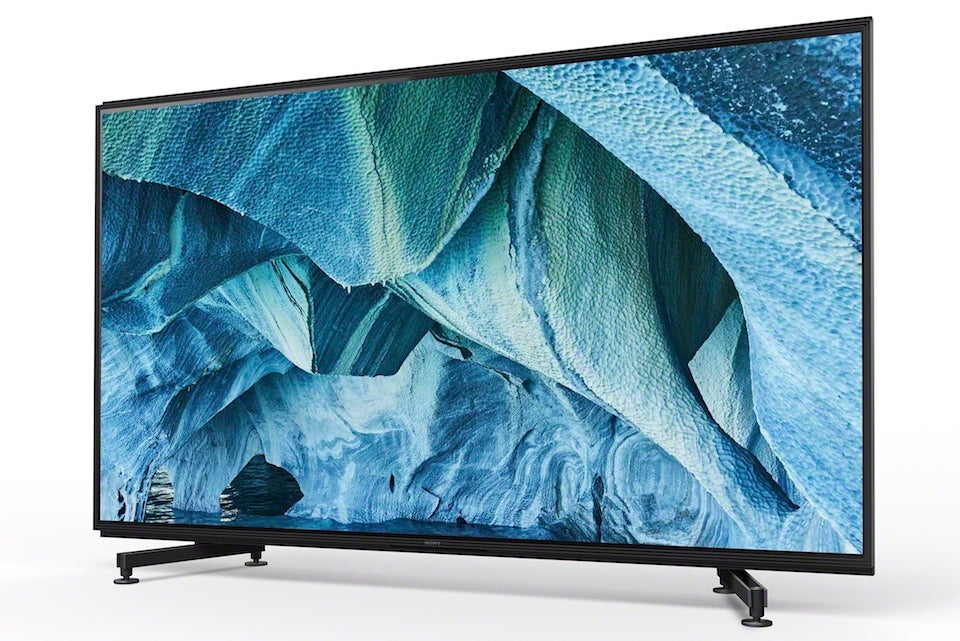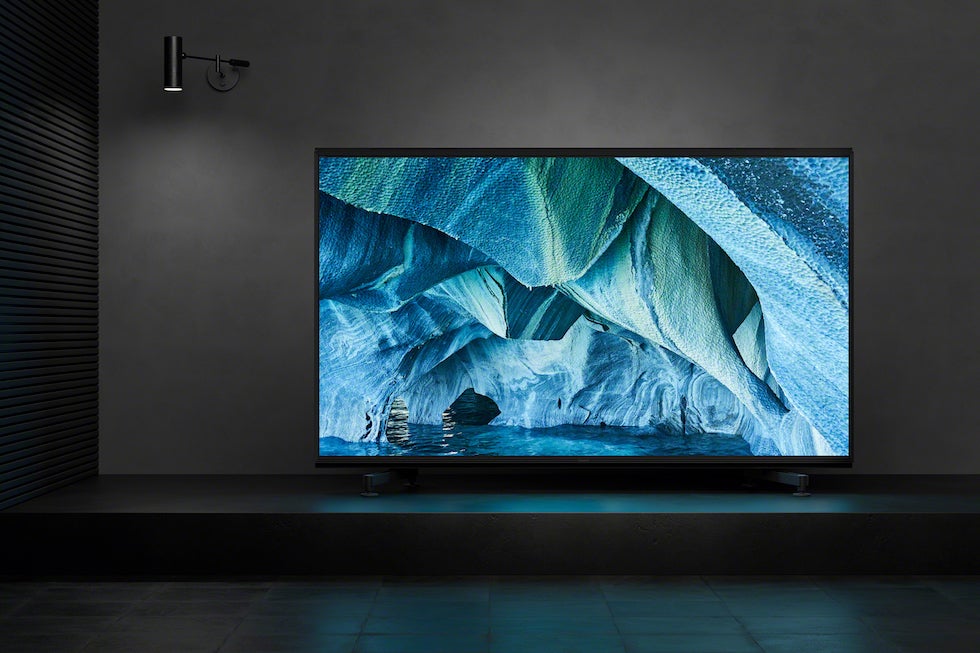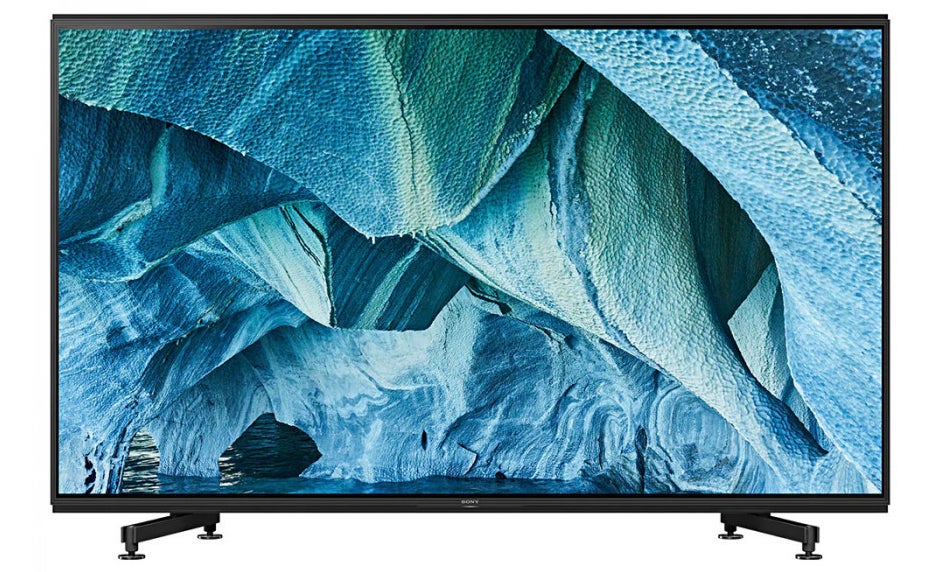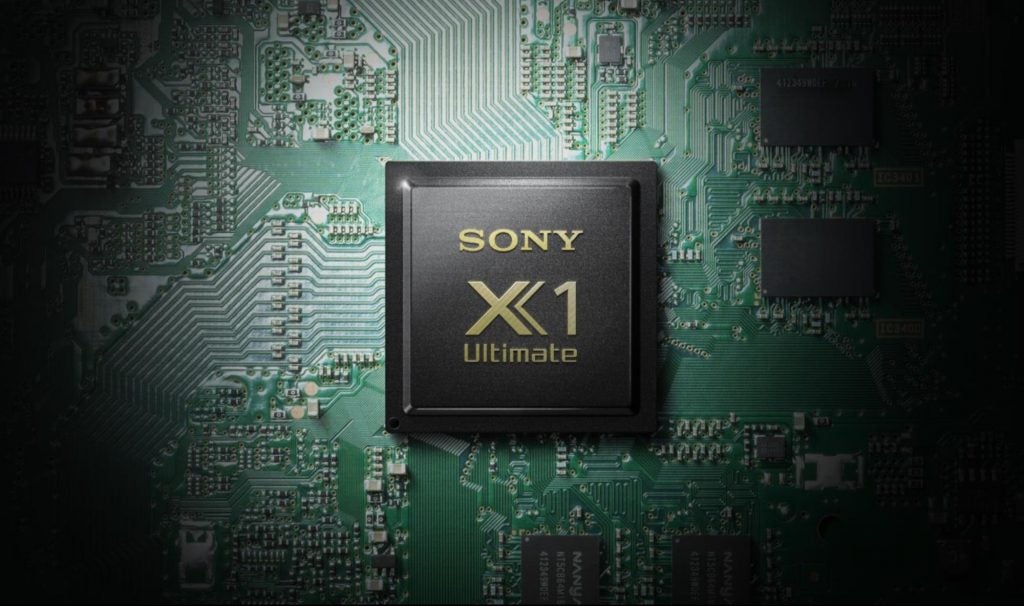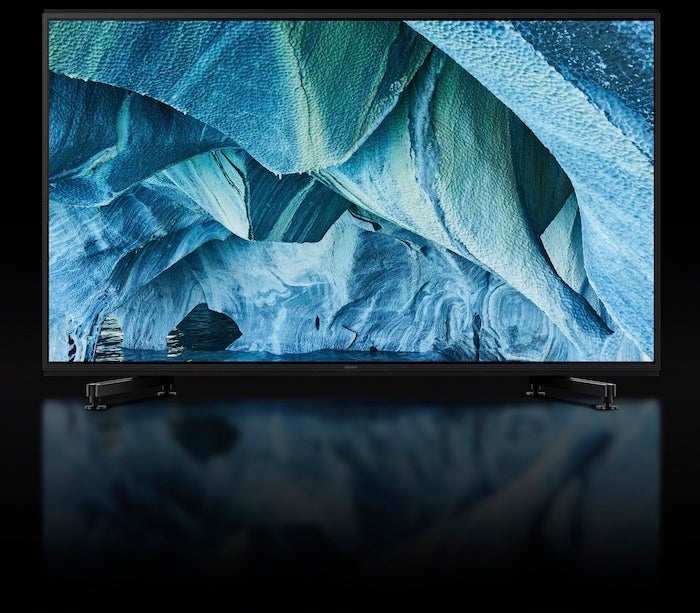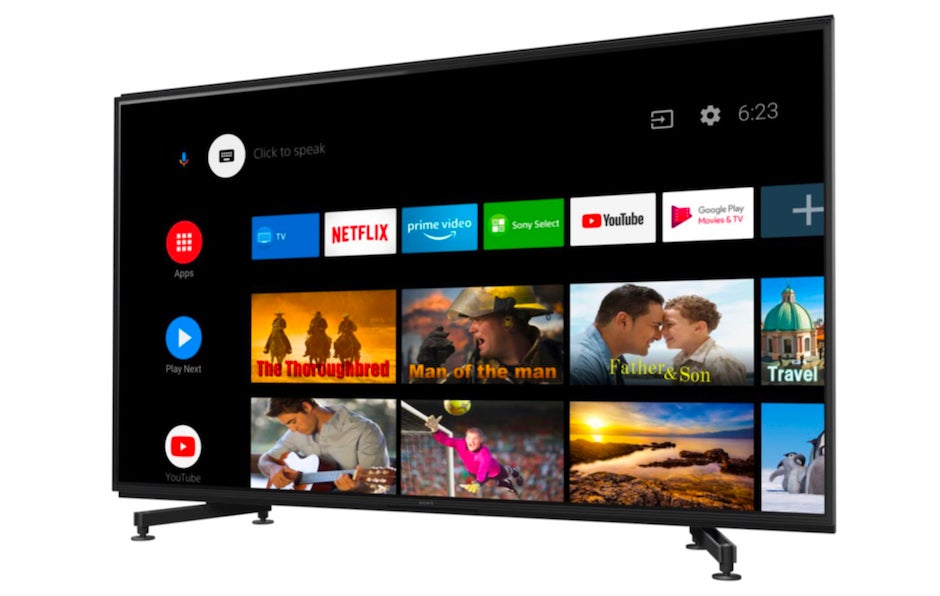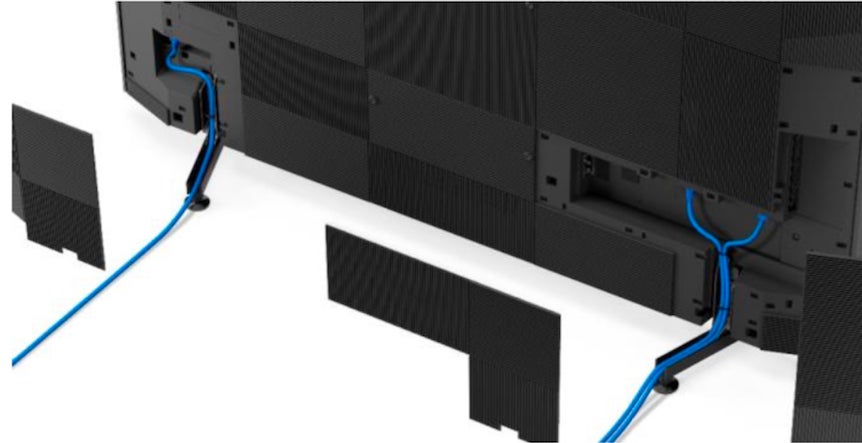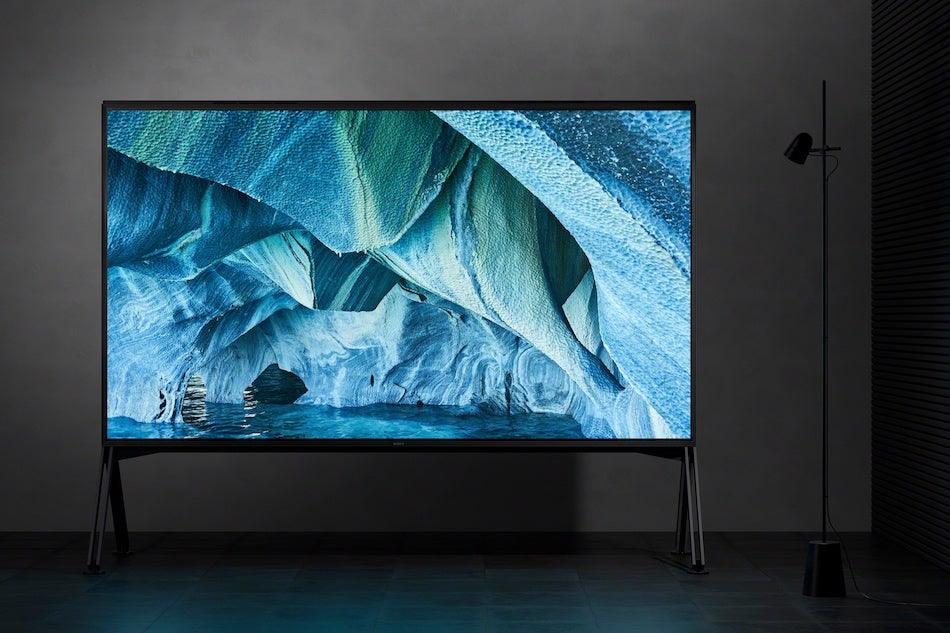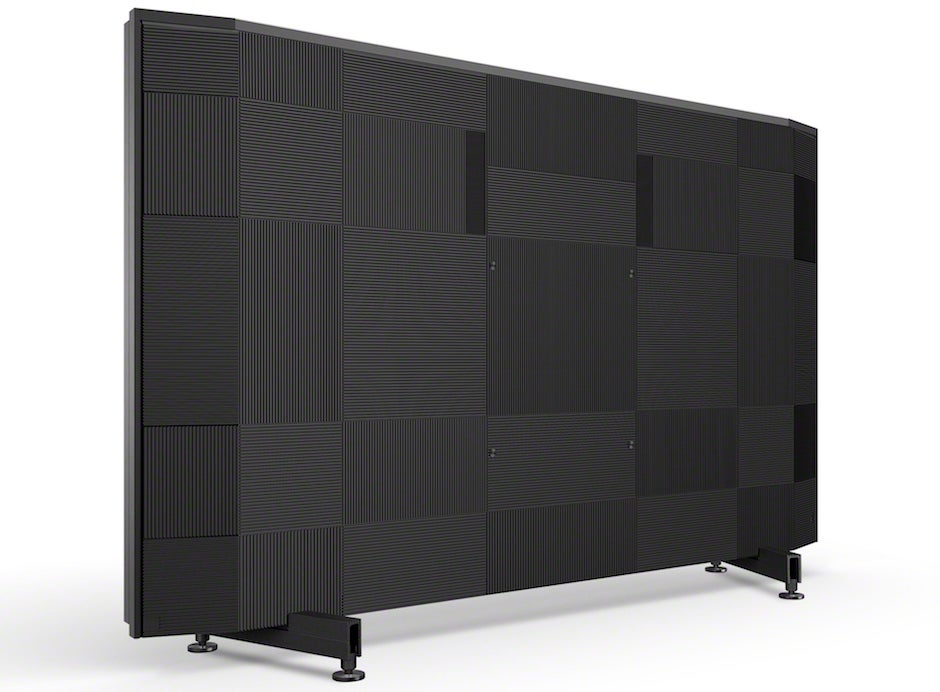Sony KD-85ZG9 Review
Sony KD-85ZG9 Review
Sony's first 8K TV is here. But 33 million pixels is just the beginning of its charms
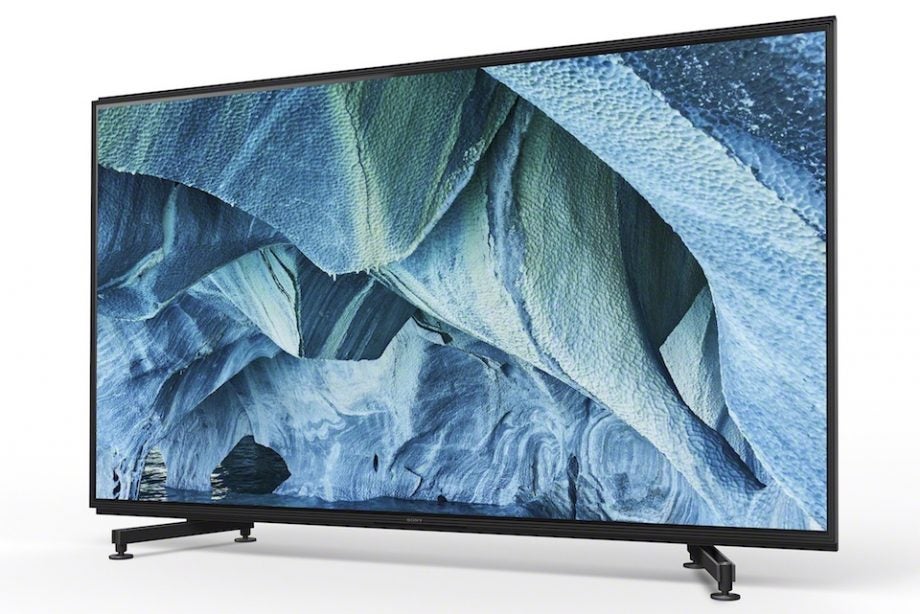
Verdict
The Sony KD-85ZG9 is a stunning, true next-generation TV, capable of delivering pictures the like of which we've never seen before. It's a shame that you probably can't afford it, then
Pros
- Sensational 8K HDR picture quality
- Very good, immersive upscaling
- Excellent video processing and backlight management
Cons
- Super-expensive
- Occasional limited backlight blooming issues
- Voices can get lost in action movie audio mixes
Key Specifications
- Review Price: £13999
- 85-inch TV with direct LED lighting system and 720 dimming zones
- Native 8K resolution
- X1 Ultimate processor
- Android Oreo smart system, plus YouView
- Dolby Atmos decoding via upcoming firmware update
What is the Sony KD-85Z9G?
The Sony KD-85Z9G is the Japanese brand’s first ever 8K TV. Sensibly it doesn’t rely on its resolution alone to justify its £14,000 price. It also boasts unprecedented levels of brightness, wide viewing angle technology, Sony’s Triluminos colour system, and Sony’s top-of-the-range X1 Ultimate processor.
Best of all, it features the long-awaited return of Sony’s Backlight Master Drive system, with its hundreds of zones of local LED dimming.
This all adds up to a spectacle the likes of which I’ve never seen before.
Related: Best TVs 2019
Sony KD-85ZG9 – Design and build quality
The 85-inch 85ZG9 isn’t just big – it’s unapologetically big. Wrapped around its huge screen you’ll find not just one frame but two, one sitting within and forward of the other.
It sits unceremoniously on a pair of fairly brutish feet, and its rear sticks out a country-mile compared with most of today’s slinky sets.
The bodywork is seriously well built, and the way the rear angles forward at its edges introduces a dash of style. Channeling in the set’s feet and rear, meanwhile, enable you to hide all of your cabling away.
The real point of the KD-85ZG9’s design is that it’s practical. For instance, the screen’s depth plays host to a direct LED lighting system with more than 700 local dimming zones. In addition, the large “double frame” houses four forward-facing speakers, each with two mid-range drivers and a separate tweeter. Two of these speakers sit in the bottom edge, while the other two, unusually, are housed along the top.
The set’s depth also lets Sony build in a couple of subwoofers to save the main drivers from becoming overwhelmed by bass.
One last bit of design news concerns the KD-85ZG9’s remote control. Finally, Sony ditches the nearly flush buttons and overcrowded layout of its previous handset. Now we get an appealing metallic finish, good button spacing and a tactile response. There’s much less chance of this unit being hurled in frustration, which is pretty handy when there’s a £14,000 television in the room.
Related: Sony TVs 2019 – All the Sony Master and Bravia TVs for 2019
Sony KD-85ZG9 – Features
To set a suitably futuristic tone for its debut 8K TV, Sony has thrown pretty much everything at the KD-85ZG9.
For starters, its 33 million-plus pixels are backed up by one of the most advanced backlighting systems in the TV world. Its LEDs are placed directly behind the screen rather than around its edges, and no less than 720 different zones of these LEDs deliver their own independent light levels at any given moment. There’s Sony’s unique calibrated beam technology, too, for focusing the light with even more accuracy.
As if this wasn’t already enough, Sony’s X-Tended Dynamic Range Pro system dynamically trades power around the screen, taking it away from dark picture areas to feed bright ones. This sort of light configuration yielded spectacular results on Sony’s ZD9 TVs a few years back, so hopefully it will do so again here.
Sony’s hugely powerful and clever X1 Ultimate processor, meanwhile, should come in handy on this 8K debutante. Especially since the database of picture knowledge it uses to quickly identify different sources has been updated to include 8K examples.
Sony’s proud upscaling heritage will hopefully step up to the 8K challenge, too, especially since there’s precious little native 8K content out there right now. And Sony’s motion processing prowess should help remove the sort of judder and motion blur that has the potential to be so damaging to 8K’s otherwise generally extreme clarity.
Then there’s Sony’s colour processing. The Triluminos colour system will hopefully help the KD-85ZG9 resolve tones finely enough to keep pace with the 8K pixel count. Sony’s Super Bitmapping system, too, will hopefully do as it has on the brand’s 4K TVs, keeping colour banding out of the ultra-pure 8K equation.
I’m more nervous about the return of the brand’s X-Wide Angle tech. This sounds good on paper – who wouldn’t want almost limitless viewing angles from an LCD TV? However, the technology did cause significant black level issues when it debuted on Sony’s 65ZF9 last year. So here’s hoping Sony has tweaked it here – or that it’s “solved” by the KD-85ZG9’s much more advanced backlighting engine.
One last picture-related feature of the KD-85ZG9 worth mentioning is its object-based HDR Remaster system. This is Sony’s system for converting standard dynamic range content into high dynamic range. Note that you can’t toggle this feature in the menus; it’s applied automatically with all picture presets bar Custom.
The Sony KD-85ZG9’s connections are good, but could have been better. The main reason I say this is that while it has four HDMIs, only one supports the latest v2.1 specification. This means that only one can support 8K at 60fps. The other three are stuck at 8K 30fps.
This is arguably not that big a deal right now given the current lack of any external 8K sources. But a bit more future-proofing might have been nice given how forward-thinking the TV is in other ways. This is even more true in light of the fact that LG is offering four HDMI 2.1s on most of its 4K OLED TVs this year!
Related: What is 8K TV?
The KD-85ZG9 does support HDMI 2.1’s eARC feature, however. This means you can pass lossless Dolby Atmos or DTS:X audio out through the TV’s HDMIs to soundbars or receivers. Strangely, though, Sony hasn’t opted to support the HDMI 2.1-related variable refresh rate gaming feature. There is some succour for gamers, however, in the shape of a respectably low 30ms of input lag using the Game picture preset.
The unusual speaker arrangement in the Sony KD-85ZG9 will eventually support Dolby Atmos audio playback. At the time of writing this feature hadn’t been enabled; apparently it will be added via a firmware update later in the year.
Related: What is Dolby Atmos? All you need to know
Finally, the Sony KD-85ZG9’s smart features come courtesy of Google’s Android Oreo. This isn’t particularly great news in my opinion. After all, while Oreo is an improvement on previous Android TV generations, it still feels cumbersome and dictatorial. Certainly when compared with the likes of LG’s webOS and Samsung’s Eden 2.0 platforms.
Its main issues are that the homescreen takes over the whole screen rather than just part of it; it isn’t as customisable as I’d like, and that it still isn’t clever enough about learning and prioritising your preferred types of content.
However, it does run more slickly and stably than before. Plus, there’s noticeably more focus on highlighting video over game content, which seems pretty sensible when you’re working in a TV rather than a smartphone or PC environment.
The UK implementation of Android TV still doesn’t include all the catch-up apps for the UK’s key terrestrial broadcasters. However, Sony has compensated for this by separately providing YouView. This incorporates all the UK catch-up services into one umbrella app, and lets you browse catch-up content via a simple electronic programme guide that looks backwards as well as forwards in time.
Related: What is HDMI 2.1?
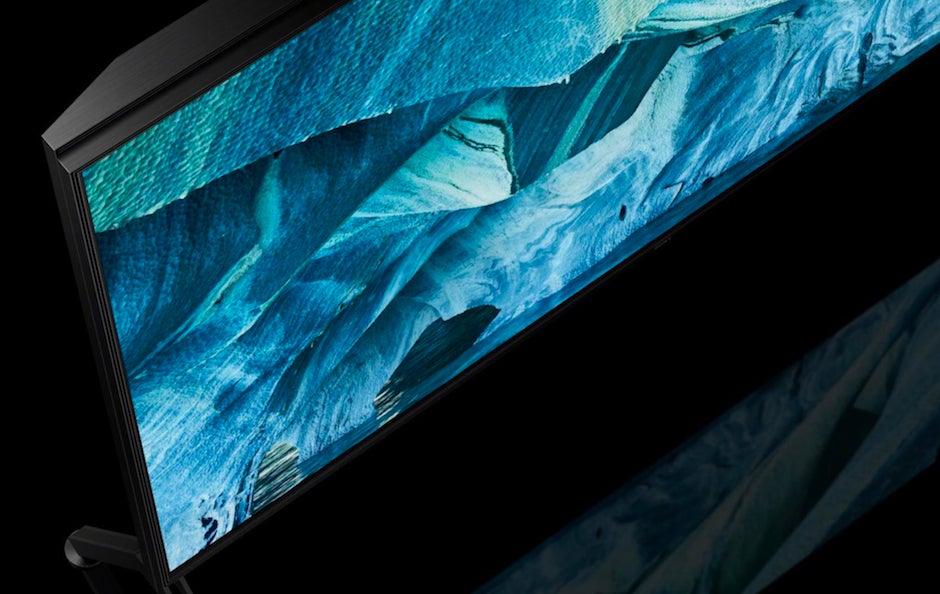
The KD-85ZG9’s rear angles sit forward towards the screen’s edges. A design element Sony optimistically calls the “blade”
The Sony KD-85ZG9’s HDR support includes the industry standard HDR10 format, Dolby Vision, and the HLG platform mostly designed for broadcast implementations. But there’s no support for the relatively new HDR10+ platform – which, like Dolby Vision, adds extra scene-by-scene information to the HDR stream.
Sony argues that it doesn’t need it for HDR10+, since its own video processors can deliver the same sort of results. Having seen HDR10+ enhance the look of titles such as Alien and Bohemian Rhapsody, even on high-end Samsung TVs however, personally I’d like to see it supported by Sony too. Although let’s not forget that Samsung for its part doesn’t support Dolby Vision…
Related: Dolby Vision HDR – Everything you need to know
Sony KD-85ZG9 – Setup
With HDR content, I’d recommend using the Custom preset for the majority of your viewing time – at least when watching films. This provides the most effective all-round control and balance of the TV’s backlighting system. In particular, it suffers less with backlight blooming than other preset options.
Whether you stick with the Custom picture mode for SDR viewing depends on whether or not you want to avoid Sony’s HDR remastering. All other settings automatically turn on the HDR conversion. Personally, I think Sony’s HDR Remaster system works so well, in general I preferred to use it. But the set still does great with SDR in its native form, if that’s your preference.
When it comes to motion processing, almost all the provided modes are superior to the motion processing options of most TVs, so feel free to experiment.
Make sure the Local Dimming setting is on at least Medium; otherwise, black levels take a severe hit. I’d also recommend setting the Advanced Contrast feature on Medium. This doesn’t give the most explosive dynamic image, but it improves shadow detail and makes the picture feel more balanced.
One last thing to consider is your preferred HDR picture preset. The Custom mode produces the least detail clipping in very bright picture areas, but the Cinema setting produces a more intense, punchy look, at the expense of bright detail.
Sony KD-85ZG9 – Performance
Not surprisingly, I couldn’t resist kicking testing off with the Sony KD-85ZG9’s native 8K performance – which, not surprisingly, meant turning to 8K footage specially shot by Sony. After all, unless you live in Japan and can watch NHK’s 8K channel, you’ll have one hell of a job finding native 8K content anywhere else – especially since Sony’s debut 8K TVs don’t support YouTube’s 8K content compression format.
Sony has certainly gone to town on its 8K showreel. Five clips were provided, all mastered in HDR, and all of them looked nothing short of breathtaking; undeniable adverts for the difference 8K can make to the viewing experience. Especially when you’re talking about screens as big as the 85-inch one under scrutiny here.
Detail levels are truly immense. The way the screen can resolve what feels like individual grains of glitter in footage of the Rio Carnival, or distant leaves and brickwork in huge depth shots across landscapes and cities, has to be seen to be believed.
In fact, the resolution reaches the point where you don’t even feel like you’re looking at image detail any more. It just feels like you’re looking at the real world. The whole sense of a screen is gone – and I absolutely love it.
What’s more, the impact of this sense of reality – which includes a startlingly enhanced sense of depth – holds up from a pretty regular seating distance. So while Sony was keen to sit me at a distance of 1.5x screen height from the KD-85ZG9, native 8K still delivered palpable benefits from further away.
Of course, just having more than 33 million pixels in a screen will get you only so far. Happily, the Sony KD-85ZG9 provides all the support tools necessary to unlock 8K’s full potential. For instance, its motion processing does a great job of suppressing LCD TVs’ blurring and juddering issues during relatively action-packed Sony 8K footage such as the Rio Carnival clip and stunning footage of driving game Gran Turismo running in 8K.
Colours, too, are resolved down to the tiny pixel level made possible by 8K TVs. This enhances the resolution’s impact on the TV’s sense of realism.
There’s no hint of any banding or blocking in even the subtlest colour blend, either. Partly due to the pixel density of the 8K screen, but also, I suspect, thanks to Sony’s ever-reliable Super Bit mapping processing, which smooths away any potential colour striping issues.
One final contributor to the Sony KD-85ZG9’s extraordinary native 8K HDR pictures is its outstanding backlight system. For starters, it delivers a remarkable 3700 nits of brightness on a white HDR box covering 10% of the screen. This incredibly high light output is within touching distance of the 4000 nits achieved by the megabucks, water-cooled mastering monitor Dolby uses when mastering home video titles in Dolby Vision.
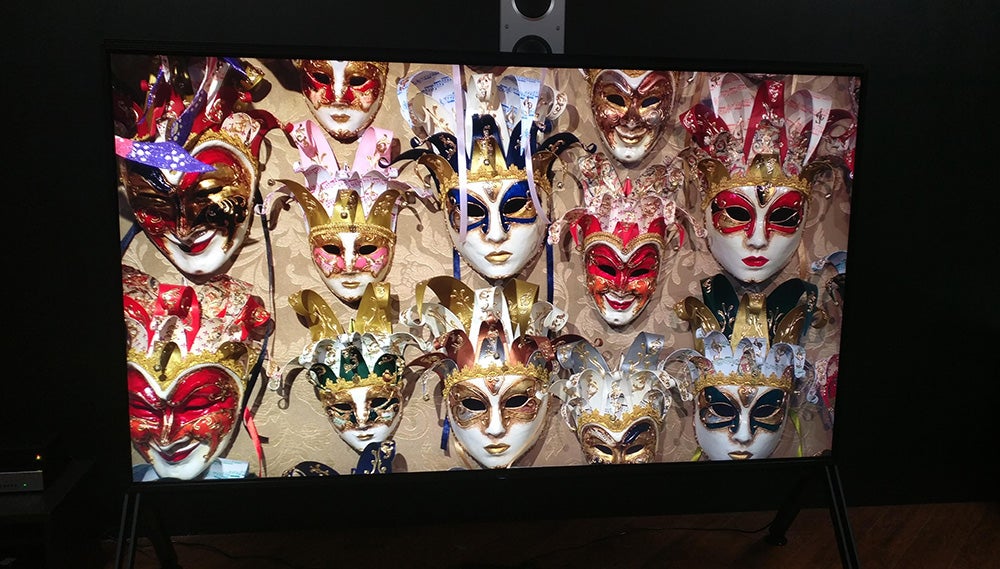
What really helps the KD-85ZG9’s HDR pictures pop, however, is the combination of its extreme brightness with the contrast control provided by having more than 700 separate dimming zones. This enables it to deliver impressively deep black levels and seriously punchy light highlights within a single shot.
What’s more, despite the image’s brightness, the KD-85ZG9 delivers its high levels of HDR dynamism without throwing up much backlight blooming around stand-out bright objects. In fact, the lighting system’s ability to pick out very small but extremely bright HDR highlights is like nothing I’ve seen before. As is its ability to hold on to high levels of brightness when showing uniformly bright HDR pictures.
The Sony KD-85ZG9’s excellent contrast performance is miles better than that of Sony’s previous flagship 4K TV, the KD-65ZF9 – even though the new 8K TV uses the wide viewing angle technology that contributed to the KD-65ZF9’s contrast issues.
I can’t say if this improvement is purely down to the 8K model’s Sony’s Backlight Master Drive lighting system, or whether Sony has somehow tweaked the wide angle technology. But it’s a huge relief to find that the Sony KD-85ZG9’s pictures hold up from any angle, yet now also enjoy good core black levels.
Shifting to the sub-8K content that will be its main source of sustenance for the forseeable future, the Sony KD-85ZG9 continues to impress. Upscaled 4K and HD content looks both remarkably clean and engaging. Not emphatically more detailed or crisp than it would on a good 4K TV, perhaps, but crucially unaffected by unwanted processing side effects or upscaling inconsistencies.
What’s more, while Sony’s upscaled 8K pictures don’t seem quite as sharp as those of Samsung’s 8K TVs (although I couldn’t confirm this with direct side by side testing), they feel more consistently organic, for want of a better word. Also, the sheer “pixels per inch” effect 8K brings – especially on TVs this big – makes upscaled pictures look somehow more real; less like mere pixels on a screen.
It’s startling, too, how effectively the Sony KD-85ZG9’s upscaling holds up with even super-low quality sources, such as heavily compressed standard definition online streams or digital broadcasts. At least when it comes to handling the various noise elements inherent to such images.
That said, the most “8K-like” pictures do come from the very best quality 4K sources – the 16:9-ratio IMAX sections of the Mission: Impossible – Fallout 4K Blu-ray, for example.
Sony’s HDR up-conversion system is another processing triumph. Sony is, as noted earlier, so confident about this that it applies it by default to SDR sources with most of its picture presets. And it’s remarkable how effectively it opens up the colour and brightness of SDR images, without the results looking unnatural or uneven.
While the KD-85ZG9 is capable of producing the finest pictures I’ve ever seen on a TV, inevitably it isn’t perfect. The biggest issue is that while its backlight system is in most ways outstanding, very intense, contrast-rich images can cause a little backlight clouding. This is generally limited in terms of when it appears, but can occasionally distractingly impinge on the black bars above and below 2.35/2.4:1 pictures.
Related: Why IMAX is the biggest game in town – Interview with CTO Brian Bonnick
The blooming tends to be slightly more noticeable with Dolby Vision sources, thanks to DV’s extra dynamics and 4000-nit mastering. It also becomes more noticeable if you’re watching the TV from much of an angle. To be clear on all this, though, considering how big and extremely bright this TV is, blooming issues are actually remarkably well controlled, and only appear over a pretty limited selection of image types.
On a couple of occasions I also spotted a strange “black hole” effect over the very brightest peaks (glinting metal, for instance) in aggressively mastered HDR images – as if the screen’s overdrive technology was being forced into some sort of meltdown. This issue is rare, though, and my feeling is that Sony may be able to fix it via firmware.
The Sony KD-85ZG9’s core black levels aren’t always as deep as those you get from Samsung’s latest 8K TVs. There’s a pretty key trade off for this, though, with the Sony doing a more consistently great job of revealing low-brightness details in dark scenes.
Sony’s 8K debutante doesn’t deliver as wide a range of colour tones as Samsung’s QLED TVs, which just occasionally leaves a (usually dark) colour tone or two looking a touch strained.
Finally, I wasn’t quite as blown away by the Sony KD-85ZG9’s audio as I’d hoped to be. It’s decently powerful, and delivers a widespread “wall of sound” effect. The soundstage has plenty of dynamism and detail, too, and has the bass and dynamism to swell powerfully for action scenes. However, it doesn’t deliver as much room-filling presence as I’d hoped a forward-facing, four-speaker system might. Also, voices can become pretty subdued in a dense mix.
Why buy the Sony KD-85ZG9?
The Sony KD-85ZG9 has only two similarly sized 8K rivals right now: Samsung’s 82-inch and 85-inch Q950Rs. These are significantly cheaper than Sony’s set, and deliver deeper black levels and sharper upscaling.
Samsung also delivers a slightly wider colour range than the Sony – although for much of the time, the exceptional brightness and light control of the KD-85ZG9 disguises this very nicely.
The KD-85ZG9 renders dark-scene detail more effectively, however, and delivers the most dynamic and dramatic HDR pictures I’ve ever seen. The sort of experience only a huge number of local dimming zones can provide on an LED TV.
Its 8K performance is outstanding, too, with phenomenal detail and colour resolution. While its upscaled pictures may not match the sharpness of Samsung’s, they arguably offer a more immersive, consistent feel.
The Sony also provides a terrific SDR-to-HDR conversion system, while Samsung has done away with its own such system this year. Sony’s TV generally sounds better than the Samsung models, too.
A separate issue is whether you actually need an 8K TV in a time when no 8K content is available. Personally, if you can afford it, I think it is. Sony’s upscaling engine works well, at least to the extent that pictures don’t look worse than they do on native 4K TVs, while benefitting from 8K screen’s extra pixel density. And it’s worth bearing in mind that the next PlayStation will apparently carry some sort of 8K support, while Rakuten has suggested it will start 8K streams this year.
In short, 8K content will come – even if only in very limited quantities in the short to mid-term.
Related: What is HDR? – High Dynamic Range explained
Verdict
The Sony KD-85ZG9 is capable of delivering the most spectacular and gorgeous pictures the TV world has ever seen.
Of course, most of us mere mortals won’t be able to find the £13,999 necessary to procure a Sony 85ZG9. But I’m seriously, seriously jealous of anyone who can.
How we test televisions
We test every TV we review thoroughly over an extended period of time. We use industry standard tests to compare features properly. We’ll always tell you what we find. We never, ever, accept money to review a product.
Trusted Score
Score in detail
-
Features 9
-
Value 7
-
Smart TV 7
-
Image Quality 10
-
Design 8
-
Sound Quality 8
Features
| Size (Inch) | 85 |
| Display Type | LED |
| Max. Resolution | 7680 x 4320 |
| Full HD 1080p | Yes (8K) |
| Freeview HD | Yes |
| Freesat HD | No |
| 3D Ready | No |
| Refresh Rate (Hertz) | 100 |
Connectivity
| HDMI | 4 |
| Component | 1 |
| Digital Audio Out | 1 (optical) |
| Headphone | Yes |
| Ethernet | Yes |
| WiFi | Yes (built in) |
Physical Specifications
| Height (Millimeter) | 1141 |
| Width (Millimeter) | 1913 |
| Depth (Millimeter) | 120 |
| Weight (Gram) | 71700 |

